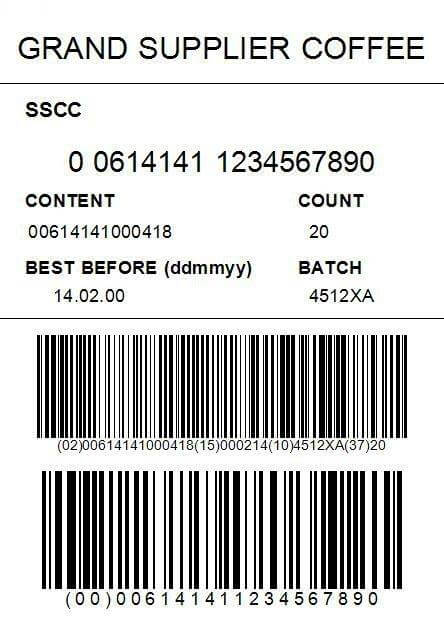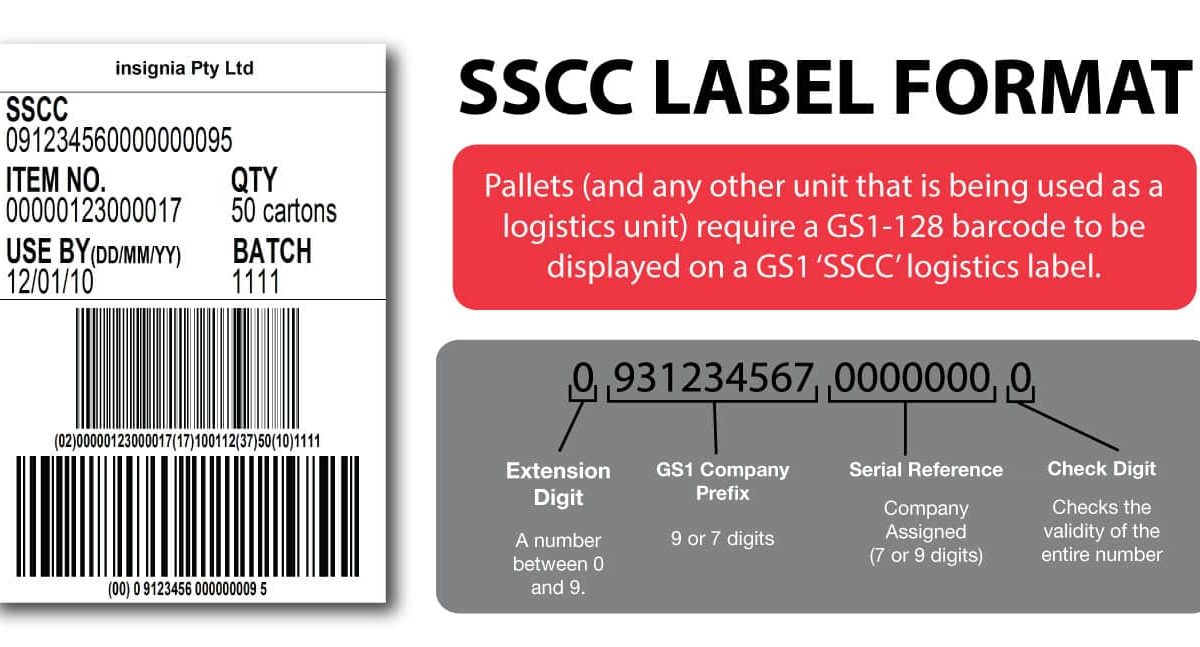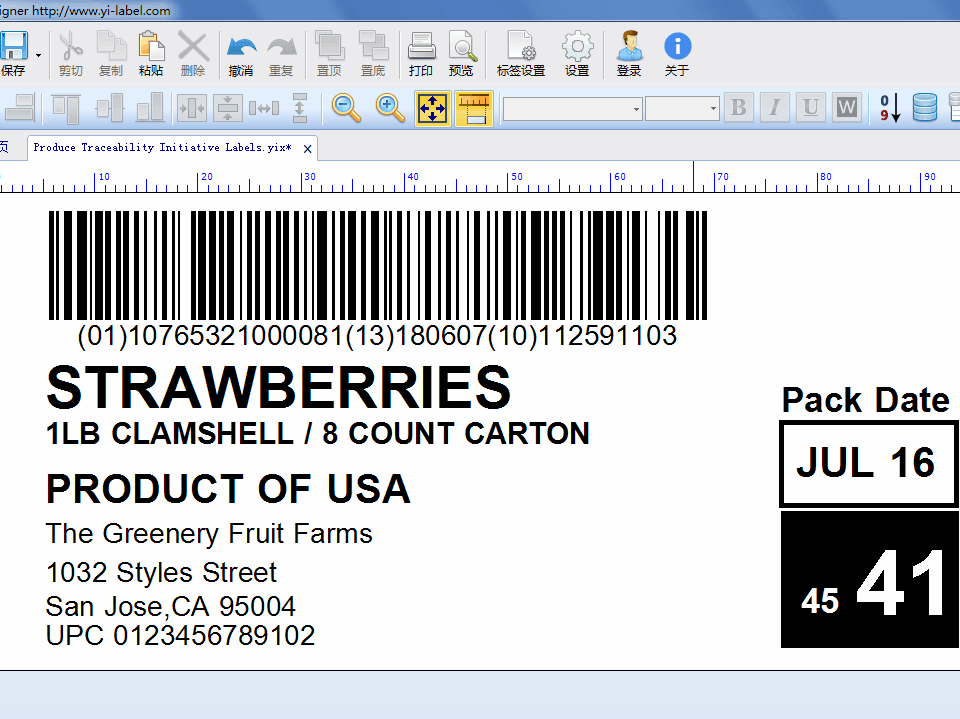SSCC:Serial Shipping Container Code
Standard international logistics labels are designed to replace confusing and repetitive labeling practices with standardized data structures, label designs, and label placement standards. The only requirement for the best practices used to label logistics units around the world is that each logistics unit must have a unique serial number or “serial shipping box code” (SSCC) identifier.
The Serial Shipping Container Code (SSCC) is a globally unique code that provides a unique identifier for a logistics unit (transport and/or storage). The logistics unit identification code consists of four parts: extension bit, manufacturer identification code, serial number and check code, which is an 18-digit numeric code.
The format of the label cell label
Label composition
A complete logistics unit label consists of three label segments, typically in order from top to bottom: carrier segment, customer segment, and supplier segment. Each segment represents a combination of a class of information in two basic forms. The label text content is located above the label segment and the barcode symbology is located below the label segment. Among them, the SSCC barcode symbology should be located at the bottom end of the label. See Appendix B for examples of labels.
SSCC is a must for all logistics unit labels, and other information should be used in conjunction with the application identifier AI if needed and comply with the provisions of 4.1.2.
Carrier segments
Carrier segments typically contain information that is determined at the time of loading, such as arrival postal codes, shipping codes, carrier-specific routing, and loading and unloading information. See Appendix B for examples of labels.
Customer segments
Customer segments typically contain information that the supplier has identified at the time of ordering and order processing. It mainly includes the arrival location, purchase order code, customer-specific route and cargo loading and unloading information.
Vendor segments
Vendor segments typically contain information that the vendor identified at the time of packing. SSCC is the only identification code that a logistics unit should have. Examples of labels are provided in Appendix B.
Product attribute information required by customers and carriers, such as product variants, production dates, packaging dates and expiry dates, batch numbers (group numbers), serial numbers, etc., can also be represented in this section. See for label examples

Label size
Users can choose between 105mm×148mm (A6 size) or 148mm×210mm (A5 size) according to their needs.
When there is only SSCC or SSCC and other small amounts of data, 105mm × 148mm can be selected.
Technical requirements
Barcode symbology
The barcode symbology on the label of the logistics unit should comply with the following requirements and the provisions of GB/T15425.
Size requirements
The size of one X is as small as 0.495mm and as large as 1.016mm. The larger the X size selected within the specified range, the higher the scanning reliability.
The height of a barcode symbol should be greater than or equal to 32mm.
The position of the barcode symbology on the label
The bar and empty bars of the barcode symbology should be perpendicular to the bottom surface of the logistics unit. In any case, the SSCC barcode symbology should be located at the bottom of the label.
Human-readable characters can be placed in the upper or lower part of the barcode symbol, including the application identifier, data content, check digit, but not the representation of special symbol characters or symbol check characters. App identifiers should be distinguished from data content by parentheses. The height of the character for human reading is not less than 3mm, and it is clear and easy to read, located at the lower end of the barcode symbology.
Preparation of cargo consignment units and shipping unit codes
- The shipper, freight forwarder, or carrier may consign/ship multiple logistics units together as a whole, so that the consignment/shipment may contain one or more physical entities that do not need to be physically attached together, but instead adopt cargo consignment code Al (401) and shipment identification code AI(402) to identify a logical combination of goods to be transported as a whole. When the cargo consignment code Al(401) or shipping identification code Al(402) identified on a physical entity is read, it indicates that the physical entity should be linked to other physical entities marked with the same cargo consignment code Al(401) or shipping identification code Al(402).
- Any single physical entity within the logical combination of goods transported as a whole shall be assigned a separate SSCC and comply with the regulations.
- The cargo consignment code is prepared by the freight forwarder, the carrier or the consignor with which the freight forwarder has entered into a prior agreement. AI (401) and its corresponding encoding data format see GB/T16986-2009.
- The shipping identification code (bill of lading) Al(402) is prepared by the consignor. AI(402) and its corresponding encoding data format are shown in GB/T16986-2009. Its barcode symbology should be placed in the carrier section.

Commodity barcode logistics unit code and barcode representation example template download
- Download “Basic logistics unit label-a SSCC.yix” Basic_logistics_unit_label-a_SSCC.yix – Downloaded 1054 times –
- Download “Contains the logistics unit tags of the supplier and carrier sections.yix” Contains_the_logistics_unit_tags_of_the_supplier_and_carrier_sections.yix – Downloaded 1033 times – 103.35 KB
- Download “SSCC-GRAND-SUPPLIER-coffee-label” SSCC-GRAND-SUPPLIER-COFFEE.yix – Downloaded 1487 times – 25.31 KB




